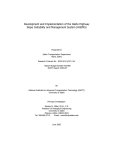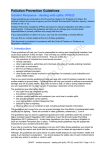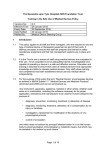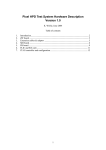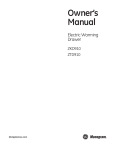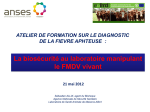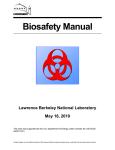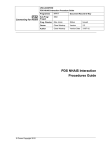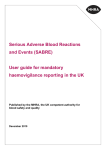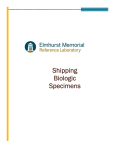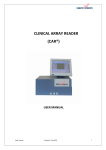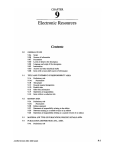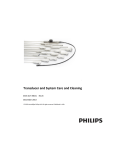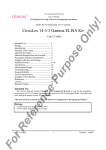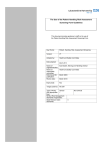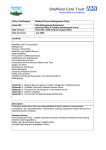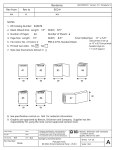Download BWH Trust policy - Birmingham Women`s Hospital Foundation Trust
Transcript
Policy for Labelling
and Transporting
Laboratory Specimens
Policy category and number:
Version:
Name of approving committee:
Ratified by:
Date ratified:
Date issued:
Review date:
Name of Lead Officer
Name of originator/author:
Job title of author:
Target audience:
B 7466
3.0
Clinical Governance Committee
Clinical Governance Committee
4th November 2011
29th November 2011
4th November 2014
Nigel Coles
Nigel Coles
Quality Manager
Trust-wide
Policy Title: Policy for Labelling and Transporting Laboratory Specimens
Policy Number: 7466
Version: 3.0
th
Issue Date: 29 November 2011
Birmingham Women’s NHS Foundation Trust
Page 1 of 21
Version Control Sheet
Version
Date
Author
Status
1.0
May 2008
Archived
1.1
Nov 2009
Nigel Coles, Head
BMS – Clinical
Chemistry
Nigel Coles, Quality
Manager
2.0
Jun 2011
Nigel Coles, Quality
Manager
Archived
3.0
Oct 2011
Nigel Coles, Quality
Manager
Approved
Archived
Policy Title: Policy for Labelling and Transporting Laboratory Specimens
Policy Number: 7466
Version: 3.0
th
Issue Date: 29 November 2011
Birmingham Women’s NHS Foundation Trust
Description of
Amendment
New Document
Delete reference
to multiple
sclerosis
• Update to
ADR 2009
Regs and
CDG 2009
Regs
• Add
reference to
Procedure for
labelling and
transporting
placenta
samples in
Delivery suite
• Minor
typographical
errors
• Change to
new trust
policy format.
• Comply with
CPA
standards
v2.02
• Update to
waste
disposal bags
• Change to
directorate
• Updated by
Jim Gray,
Consultant
Microbiologist
to supersede
previous
separate
infection
control policy
entitled
Specimen
collection,
handling &
transport
Policy
Page 2 of 21
Contents
1.
Introduction .................................................................................................... 4
2.
Objectives ...................................................................................................... 4
3.
Policy Scope .................................................................................................. 4
4.
Indemnity Statement ...................................................................................... 4
5.
Definitions ...................................................................................................... 5
6.
Duties and Responsibilities ............................................................................ 5
6.1
Directorate Managers .................................................................................... 5
6.2
Medical Staff .................................................................................................. 5
6.3
Clinical Staff (includes Medical, Midwifery, Nursing and Phlebotomy Staff) .... 6
6.4
Portering Manager / Associated Staff in Clinics, Patients’ Homes .................. 7
6.5
Portering Staff / Associated Staff in Clinics, Patients’ Homes......................... 7
6.6
Laboratory Managers ..................................................................................... 8
6.7
Transport Drivers ........................................................................................... 8
6.8
External Taxi / Local Transport Providers ...................................................... 9
7.
Procedures .................................................................................................... 9
7.1
Categorisation of Specimens ......................................................................... 9
7.2
Specimens that Contain Other Hazardous Materials .................................... 10
7.3
Fresh Un-fixed Histology Specimens ........................................................... 10
7.4
transportation of Specimens by Road .......................................................... 10
7.5
Specimen Transport Procedure within the Hospital ...................................... 11
7.6
Transportation of Specimens by Taxi / Local Transport Providers and
Community Midwives from the Birmingham Women's Hospital .................... 11
8.
Review, Monitoring, and Revision Arrangements ......................................... 11
9.
Associated Documents ................................................................................ 12
10.
References .................................................................................................. 12
Appendix A – List of Samples Considered “High Risk” ............................................ 13
Appendix B – Spillage Kit Procedure ....................................................................... 14
Appendix C – Packing Instructions Used for Specimen Collection and Transport.... 15
Appendix D – Safety Rules for Community Midwives, Porters and Drivers .............. 16
Appendix E – Plan for Dissemination of Procedural Documents .............................. 17
Appendix F – Equality Impact Assessment Tool ...................................................... 18
Appendix G – Policy Checklist................................................................................. 20
Policy Title: Policy for Labelling and Transporting Laboratory Specimens
Policy Number: 7466
Version: 3.0
th
Issue Date: 29 November 2011
Birmingham Women’s NHS Foundation Trust
Page 3 of 21
1.
Introduction
Health and safety legislation requires laboratory staff to process separately from
other work, using special precautions, any specimens which are known to present, or
are suspected of presenting, a risk or danger of infection to laboratory staff.
In a hospital\clinic, it is likely that at any given time, there will be a number of patients
presenting a risk of infection that are not identified, either because the diagnosis of
clinical illness has not been made, or because the risk is present in the carrier state.
Therefore, there is a need to ensure that all specimens are safely handled, contained
and transported from the patient to the laboratory.
If a specimen is known to present, or is suspected of presenting an infection hazard,
it is essential that staff can identify the specimen and are given information sufficient
to enable them to take the appropriate precautions.
The NHS Litigation Authority (NHSLA) expects a safe system of work to be in place,
which ensures correct patient identification of specimens and reports, and the
procedure to be adopted in cases where specimen mislabeling occurs.
The Carriage of Dangerous Goods and Use of Transportable Pressure Equipment
Regulations 2009 ("CDG 2009"), came into force on 1 July 2009. They replace the
2007 regulations. The Regulations implement ADR 2009 (with a number of
exceptions) which is explicit in the packaging requirements for the transport of
dangerous goods by road. The Royal Mail also provides explicit requirements for the
inland posting of diagnostic samples, which comply with the ADR regulations.
This document also describes the process for monitoring the effectiveness of the
policy and associated procedures.
Information about the sampling requirements for specific assays can be obtained by
either phoning the appropriate laboratory or referring to each laboratory User Manual.
2.
Objectives
The objectives of this policy are to describe a safe system for the labelling, packaging
and storage of pathological specimens at ward/clinic level and principles for safe
transportation to the laboratory by hospital porters’ and\or the use of hospital
transport, taxis, couriers or the postal services.
3.
Policy Scope
This policy applies to all employees who take specimens, label them and or transport
them to a laboratory, irrespective of grade, level, location or staff group.
4.
Indemnity Statement
The Trust will generally assume vicarious liability for the acts of its staff, including
those on honorary contract. However, it is incumbent on staff to ensure that they:
• Have undergone any suitable training identified as necessary under the terms
of this policy or otherwise
• Have been fully authorised by their line manager and their Directorate to
undertake the activity
Policy Title: Policy for Labelling and Transporting Laboratory Specimens
Policy Number: 7466
Version: 3.0
th
Issue Date: 29 November 2011
Birmingham Women’s NHS Foundation Trust
Page 4 of 21
•
•
5.
Fully comply with the terms of any relevant Trust policies at all times
Only depart from any relevant Trust guidelines providing that such departure
is confined to the specific needs of individual circumstances. In healthcare
delivery such departure shall only be undertaken where, in the judgement of
the responsible clinician, it is fully appropriate and justifiable. Such decisions
are to be fully recorded in the patient notes.
Definitions
Diagnostic Specimens – human or animal materials that are being transported only
for the purpose of diagnosis or investigation (UN3373)
Infectious Specimens – are reasonably known to contain a pathogen, and the
pathogens cause infectious diseases in humans, or animals and humans (UN2814).
6.
Duties and Responsibilities
6.1
Directorate Managers
It is the responsibility of Directorate Managers to ensure that:
•
•
•
•
•
•
•
6.2
All staff in their directorate who request, collect and transport clinical
specimens are familiar with this policy and associated procedures
All staff in their directorate have access to appropriate parts of the policy and
procedures
All staff in their directorate who handle specimens receive adequate training
and instruction of the requirements of this policy and its associated
procedures
There are adequate resources to enable this policy and its procedures to be
performed correctly and in a safe manner
Materials associated with this policy comply with standards recommended in
this policy
They, or a delegated representative, assist with any investigation or untoward
incidents, or non-compliance with this policy
They determine with appropriate managers the site of specimen storage
areas within their area
Medical Staff
It is the responsibility of medical staff to ensure that:
•
•
•
•
They are familiar with and apply this policy and associated procedures.
They are aware of the hazards involved to other staff of the non-compliance
with this policy
When requesting specimens for analysis that may present a particularly high
risk of infection, the attention of staff who may take the specimen must be
drawn to any risk to themselves and any special precautions necessary when
taking the specimen
They or staff taking these specimens are aware of any additional labelling of
the specimen container\pathology request form that may be required.
Policy Title: Policy for Labelling and Transporting Laboratory Specimens
Policy Number: 7466
Version: 3.0
th
Issue Date: 29 November 2011
Birmingham Women’s NHS Foundation Trust
Page 5 of 21
6.3
Clinical Staff (includes Medical, Midwifery, Nursing and
Phlebotomy Staff)
It is the responsibility of clinical staff taking specimens to:
•
•
•
•
•
•
•
•
•
•
Be trained in the taking of the appropriate specimens in a safe manner
Be aware of the hazards to themselves and other staff of non-compliance with
this policy
To wear appropriate personal protective equipment
Where possible, to avoid removing used needles from syringes, and on no
account to resheath needles
Ensure the container used is the appropriate one for the purpose is properly
closed and is not externally contaminated by the contents.
Ensure every request form and specimen container, must contain the
following details to allow laboratory staff to provide the service requested and
to resolve issues, should the need arise:
o describes the nature of the specimen
o the patient identity information that allows for unequivocal
identification of the patient.
Hospital Registration number or NHS number
Surname
Date of birth
o location
o date and time specimen is taken
o type of specimen and where appropriate anatomical site of origin
o requestors contact details
o appropriate clinical information.
o investigations required
o identity of priority status
Ensure the appropriate labelling of specimen container and pathology request
form if the patient is know or suspected of having a disease considered “high
risk”, as defined later in this policy.
Ensure the specimen is packaged and stored in a suitable and safe manner
and in a suitable place, whilst awaiting transportation to the laboratory
Ensure that any urgent specimens are adequately packaged in accordance
with this policy.
Ensure that if taken by ward staff to the central specimen reception point
within the hospital, that specimens are carried in a safe manner.
The clinician who sends the specimen must ensure that:
•
•
•
•
•
•
•
The container used is the appropriate one for the purpose, is properly closed
and is not externally contaminated by the contents
Similarly, the pathology request form must not be contaminated
The container is labelled with patient’s registration number (and NHS number
of non-registered BWH patients), full name and date of birth.
“High risk” specimens (detailed in Appendix A) must have a “DANGER OF
INFECTION” label attached to the container
For most specimens, the container is placed into the leak-proof pathology bag
with integral request form.
The bag is sealed as directed on the form.
On no account are these bags to be stapled, pinned or clipped
Policy Title: Policy for Labelling and Transporting Laboratory Specimens
Policy Number: 7466
Version: 3.0
th
Issue Date: 29 November 2011
Birmingham Women’s NHS Foundation Trust
Page 6 of 21
•
•
•
•
•
•
•
•
6.4
These bags are not to be re-used
Specimen containers which do not fit into the pathology bag are placed in a
polythene bag which is sealed by knotting or the use of tape, but never by the
use of staples, pins or clips. These bags should not be re-used. The Delivery
suite has developed a separate procedure for the packing, labelling and
transport of placenta samples (see Section 9 Associated Documents).
The appropriate request form must accompany the specimen and must give
full patient identification details. The type of specimen, time and date of
collection, the required investigation and relevant clinical details, must also be
given.
If the integral request form\envelopes are not used, the request form is
attached to the outside of the bag and not placed inside the bag with the
specimen container
Specimens awaiting collection are placed in the ward/clinic specimen
container
Specimens taken to a central reception point by ward/clinic staff for collection,
must use the above box to carry the specimens.
This box must be cleaned with detergent\water weekly or, if soiled, it must be
cleaned immediately with 1% hypochlorite solution (see Spillage Procedure,
Appendix B).
If a taxi driver arrives to collect a specimen from the ward\clinic, the specimen
must be handed over from the ward box. On no account, must the ward box
be handed over to the driver.
Portering Manager / Associated Staff in Clinics, Patients’ Homes
It is the responsibility of the Portering Manager etc to ensure that:
•
•
•
•
•
•
•
6.5
All staff in the department who transport specimens are familiar with this
policy and associated procedure.
All staff in the department have access to the relevant parts of this policy and
are trained in the requirements of this policy and its associated procedures.
The staff in the department are aware of and know to how to carry out the
procedure for dealing with spillages of pathological materials in accordance
with the Spillage Procedure. (Appendix B)
Spillage kits and appropriate protective equipment are available within the
department and staff are aware of the spillage kit and protective clothing
storage area.
All materials associated with this policy comply with standards recommended
in this policy and any equipment is maintained to an appropriate standard.
That staff have appropriate supplies of equipment and any protective clothing
necessary to perform this and associated policies.
There is liaison with the appropriate departments concerning cleaning and
disinfection of equipment used in this policy.
Portering Staff / Associated Staff in Clinics, Patients’ Homes
It is the responsibility of portering staff to:
•
Collect and transport pathological specimens in a safe manner in the
procedures accompanying this policy.
Policy Title: Policy for Labelling and Transporting Laboratory Specimens
Policy Number: 7466
Version: 3.0
th
Issue Date: 29 November 2011
Birmingham Women’s NHS Foundation Trust
Page 7 of 21
•
•
•
•
•
6.6
Convey only those specimens which are appropriately packaged and not
leaking to the point of collection
Be familiar with the procedure to be undertaken in the event of leakage or
spillage of specimens or other untoward event in accordance with the Spillage
Procedure. (Appendix B)
Not to transport pathological specimens with any other items, e.g. waste,
post, notes, x-rays, unless they are segregated from such items.
Not leave pathological specimens which are not in a locked box or similar
carrier in public areas
To observe hygiene rules given in the accompanying “Safety Rules for
Porters and Drivers” Appendix D)
Laboratory Managers
It is the responsibility of Laboratory Managers to ensure that:
•
•
•
•
•
•
•
•
•
•
6.7
All staff in the department who transport clinical specimens are familiar with
this policy and associated procedures
All staff in the department have access to appropriate parts of the policy and
associated procedures.
All staff in the department are trained in the requirements of this policy and its
associated procedures.
The staff in the department are aware of and know how to carry out the
procedure for dealing with spillages of pathological materials in accordance
with the Spillage Procedure. (Appendix B)
Spillage kits and appropriate protective equipment are available and that the
storage sites for these materials are known by all staff in the department.
All materials associated with this policy comply with standards recommended
in this policy and equipment is maintained to an appropriate standard.
There is liaison with the appropriate departments concerning cleaning and
disinfection of equipment used in this policy.
Their staff have appropriate supplies of equipment and any protective clothing
necessary to perform this and associated policies.
Suitable specimen storage facilities are available in each laboratory.
Provide specific guidance for their service users in their user’s manual.
Transport Drivers
It is the responsibility of drivers to:
•
•
•
•
•
Collect and transport pathological specimens in a safe manner as instructed
in the procedures accompanying this policy.
Convey only those specimens which are appropriately packaged and not
leaking to the laboratory.
Be familiar with the procedure to be undertaken in the event of leakage or
spillage of specimens or other untoward event in accordance with the Spillage
Procedure. (Appendix B)
Not to transport pathological specimens with any other items, e.g. waste,
post, notes, x-rays, unless they are segregated from such items.
Not leave pathological specimens which are not in a locked box or similar
carrier in public areas.
Policy Title: Policy for Labelling and Transporting Laboratory Specimens
Policy Number: 7466
Version: 3.0
th
Issue Date: 29 November 2011
Birmingham Women’s NHS Foundation Trust
Page 8 of 21
•
•
6.8
Observe hygiene rules given in the accompanying “Safety Rules for Porters
and Driver”. (Appendix D)
Specimens in transit must never be left unattended in an unsecured vehicle or
at an unsecured location
External Taxi / Local Transport Providers
The contractor must have a Health and Safety Policy which satisfies the
requirements of the Birmingham Women's NHS Foundation Trust.
•
•
•
It is the responsibility of the contractor to ensure that all their personnel are
informed of and are fully trained in the performance of this policy at all levels.
It is the responsibility of the contractor to ensure that their policies and
procedures reflect those contained within this policy.
NOTE: Specimens must not be left by drivers at the receiving Hospital’s
Porters’ Lodge. They must be taken to the appropriate department.
7.
Procedures
7.1
Categorisation of Specimens
All specimens must be handled with care and treated by all personnel as a potential
infection risk.
Low Risk Diagnostic Specimens (UN3373)
The majority of specimens collected and transported to the pathology departments
do not present a significant risk of infection to staff handling them. These may be
considered “low risk” diagnostic specimens. Such specimens will normally be
packaged in a primary container (e.g. blood tube, swab tube, specimen pot) and an
outer secondary container (a sealed pathology transport bag or sealed plastic bag).
All specimens must be accompanied by an accurately, fully completed pathology
request form which must preferably be integral and external to the bag. The tertiary
container used to transport specimens around and between hospitals may vary in
design, but must comply with the P60 specification outlined in this Policy.
High Risk Infectious Specimens (UN2814)
•
•
•
Some patients may be suffering from or be suspected of having a disease
which may present a higher risk to staff. Legislation requires specimens from
such patients to be identifiable. A list of diseases presenting such a risk and
the specimens from those patients constituting “high risk” specimens are
given in Appendix A.
The specimen containers and pathology transport bags used for these
specimens will be identical to those used for routine specimens. The
identification of risk associated with these specimens will be by the use of
“DANGER OF INFECTION” labels. The specification for these labels is given
in Appendix C.
It is the legal responsibility of the person who requests the laboratory
examination of the specimen to ensure that both the request form and the
container are correctly labelled to indicate a danger of infection. “DANGER
Policy Title: Policy for Labelling and Transporting Laboratory Specimens
Policy Number: 7466
Version: 3.0
th
Issue Date: 29 November 2011
Birmingham Women’s NHS Foundation Trust
Page 9 of 21
OF INFECTION” labels must only be used for specimens which are
suspected of or are known to contain pathogens listed in Appendix A.
7.2
Specimens that Contain Other Hazardous Materials
These include, pathological specimens which contain radioactive material, cytotoxic
drugs, and specimen containers which may contain hazardous reagents. These
represent a minority of specimens at the Birmingham Women's NHS Foundation
Trust.
The requirements for the transportation of radioactive materials by road, are
described in the ADR 2009 regulations. Local procedures for wards and departments
concerning the packaging and transportation of radioactive materials and specimens
containing radioactive residues are available and have been written with guidance
from the Radiation Protection Adviser.
7.3
Fresh Un-fixed Histology Specimens
Specimens sent for histological examination that also require Cytogenetics
analysis must be kept fresh (unfixed in formal saline). Once Cytogenetics has
taken the required sample the rest of the tissue is fixed in formal saline ready
for histological examination.
All placenta specimens from delivery suite must be sent fresh for histological
examination (Please refer to ‘Delivery Suite Procedure for the Preparation of
Placenta Specimens for Histological Examination’ - which can be found on the
Trust Intranet).
It is important that fresh specimens are stored below 4 degrees
centigrade as soon as possible, to prevent decomposition prior to
histological examination.
7.4
Transportation of Specimens by Road
The ADR 2009 Regulations set out the conditions under which specimens can be
carried by road. It gives details relating to the packaging and labelling of any
biological samples transported by such means.
In view of these requirements, it is unlikely that wards would be able to comply
without reference to the trusts laboratory services. Thus, any biological sample to be
sent to another diagnostic laboratory should only be dispatched by the laboratory.
• Any staff sending specimens through the post directly from a ward must
contact, in the first instance, the Directorate Manager within the Directorate to
which they are accountable for authorisation before specimens are sent. Any
specimens sent via the postal services must comply with current
requirements for packaging.
• Any protocols, other than those described here, for the transportation of
specimens issued from a laboratory should be checked by the Trust’s Control
of Infection team before specimens are sent through the post.
Policy Title: Policy for Labelling and Transporting Laboratory Specimens
Policy Number: 7466
Version: 3.0
th
Issue Date: 29 November 2011
Birmingham Women’s NHS Foundation Trust
Page 10 of 21
7.5
Specimen Transport Procedure within the Hospital
•
•
•
The transportation of specimens from the ward to the central point within the
hospital may be performed by ward staff or porters.
Porters and drivers must have a copy of “Safety Rules for Porters and
Drivers”. Appendix D.
Ward staff must transport the specimens in the ward specimen storage box
NOTE
•
•
7.6
Transportation of Specimens by Taxi / Local Transport Providers
and Community Midwives from the Birmingham Women's Hospital
•
•
•
•
•
•
•
•
8.
Specimens must be kept in locked area when unattended to prevent
patient\general public access to the specimens.
The boxes used to store the specimens must be washed weekly using
detergent\hot water. If soiled, they must be cleaned using the spillage kit as
directed.
An occasional “in hours” specimen and all “out of hours” specimens are
transported by private taxi.
Copies of this Policy and Procedures will be available to the contracted taxi
companies.
Taxi drivers must have a copy of “Safety Rules for Porters and Drivers”
(Appendix D) and must also be familiar with the health and safety implications
of transportation of pathological specimens and how to deal with
spillage\leakage of any specimens. (Appendix B)
Transport boxes used by drivers must conform to the standards described in
this Policy (Appendix C). Transport boxes must not be placed on the vehicle
seats. The boxes must be stored in the car boot or secured at the rear of the
vehicle if an estate\transit style of vehicle is used
The specimens must be transported in such a way that if leakage occurred, it
would be contained within the outer container
The outside of any transportation box must be labelled as per the Policy
Spillage kits and other equipment to deal with spillage must be available at
the headquarters of the vehicle’s base or within the vehicle.
Specimens in transit must never be left unattended in an unsecured vehicle or
at an unsecured location.
Review, Monitoring, and Revision Arrangements
The requirements of this policy and procedures will be continuously monitored on the
receipt of specimens in the laboratory. Significant discrepancies will be logged and
the requesting clinician will be notified. Each laboratory department will produce an
quarterly report (as part of the QQI report) detailing numbers of discrepancies and
identify any significant trends or areas of the trust which consistently disregards this
policy.
This policy will be reviewed every three years unless national or international
guidance or legislation requires revision at an earlier date.
Policy Title: Policy for Labelling and Transporting Laboratory Specimens
Policy Number: 7466
Version: 3.0
th
Issue Date: 29 November 2011
Birmingham Women’s NHS Foundation Trust
Page 11 of 21
All Trust policies / guidelines will be monitored for compliance in one of three ways:
•
•
•
Review is normally proactive and designed to evaluate the effectiveness of
systems and processes;
Audit is a quality improvement process that seeks to improve patient care
and outcomes through systematic review of care against explicit criteria;
Continuous Audits are repeated audit cycles to ensure new controls can be
identified and tested as they arise.
Where deficiencies have been identified through any of the above, there must be
evidence that recommendations and action plans have been developed and changes
implemented.
The frequency and detail of the monitoring process is described in the table below:
Monitoring
External transport
contractors
Method
Audit
Frequency Lead
Annual
Quality
Manager
Identify trends via
Incidents and/or nonconformities
Review
Annual
9.
10.
Quality
Manager
Reporting to
Genetics and
Laboratories
Directorate
Genetics and
laboratories
Directorate
Associated Documents
•
Birmingham Women’s NHS Foundation Trust Infection Control Manual.
Available on the intranet
•
Pathology User Manuals. Available at: U:\Pathology User Manual
References
Working with ADR. An introduction to the carriage of dangerous goods by road,
Department of Transport; 2004; ISBN 1-904763-4732
European Agreement Concerning the International Carriage of Dangerous Goods by
Road (ADR) 2009; United Nations, 2008. Available online at:
http://www.unece.org/trans/danger/publi/adr/adr2009/09ContentsE.html
Carriage of Dangerous Goods Manual. Available online at:
http://www.hse.gov.uk/cdg/manual/index.htm
Policy Title: Policy for Labelling and Transporting Laboratory Specimens
Policy Number: 7466
Version: 3.0
th
Issue Date: 29 November 2011
Birmingham Women’s NHS Foundation Trust
Page 12 of 21
Appendix A – List of Samples Considered “High Risk”
Suspected or Proven Infections in Category 3
All Specimens
1.
2.
3.
4.
5.
6.
HIV
Hepatitis B or C or D
Q fever
Rabies.
Transmissible spongiform encephalopathies (e.g. Creutzfeldt-Jakob
disease)
Patients who have a fever and who have recently returned from Africa (risk
of infection with category 4 pathogens)
Selected Specimens
7. Sputum and other material that may contain tubercle bacilli from patients with
suspected or proven tuberculosis.
8. CSF, brain tissues and spinal cord material from patients classified as being
at risk of having a transmissible spongiform encephalopathy.
9. Urine, faeces and blood from patients with suspected or proven typhoid or
paratyphoid fevers.
10. Faeces from patients suspected or proven to have:
a. Dysentery due to Shigella dysenteriae type 1.
b. Infection with verotoxin-producing E. coli (VTEC) (e.g. E. coli O157).
11. Upper respiratory tract specimens, blood cultures, CSF and samples from
skin lesions from patients with suspected or proven meningococcal infection,
until 24 hours after commencing appropriate antibiotic therapy.
12. Other samples as directed by Infection Control Team.
Further information can be found in the Trust’s Infection Control Manual which can be
found on the Trust intranet.
Policy Title: Policy for Labelling and Transporting Laboratory Specimens
Policy Number: 7466
Version: 3.0
th
Issue Date: 29 November 2011
Birmingham Women’s NHS Foundation Trust
Page 13 of 21
Appendix B – Spillage Kit Procedure
DISINFECTION TABLETS FOR PREPARING “HYPOCHLORITE” SOLUTIONS
Hypochlorite solutions are not very stable and this may cause problems when diluted, thus
throughout this policy fresh solutions are made using effervescent tablets.
The solutions recommended can be prepared as shown on the package.
AVOID USE ON METALLIC EQUIPMENT WHEREVER POSSIBLE.
WASH HYPOCHLORITE OFF METALLIC EQUIPMENT WITH DETERGENT AND HOT
WATER AND DRY.
For blood/body fluid spillage – see spillage section of this policy.
Where possible, ensure good ventilation when using the higher strength chlorine solutions.
Use of Spillage Kits
These kits are only for use in cases of blood and body fluid/product spillage.
NOTE: FOR URINE – SEE NOTE 3.
This spillage kit contains:
• 1 tube of 10 x 1.8g tablets
• 1 x 500g disinfectant granules
• 1 x 1 litre bottle
The following items will also be necessary to use this kit:
• Orange waste bag
• Disposable cloths or paper towels
• Hot water and detergent
• Disposable gloves
• Disposable apron
Methods of Use
1. Put on apron and gloves
2. Sprinkle granules liberally over spillage, ensuring complete coverage. Leave for at
least 2 minutes. Do not leave unattended.
3. Scoop debris into orange plastic bag.
4. Wipe up with damp paper towel any remaining powder – put paper towels into orange
bag,
5. Wipe area with detergent and hot water.
6. Put all disposable equipment, gloves, apron etc into orange bag and seal.
7. Wash hands.
As an alternative to granules, 1 tablet may be dissolved in 100ml of water to give a
hypochlorite solution of the same strength. This would only be for large volume or vertical
spillages.
A fresh solution must be made up for each incident and disposed of carefully down the sluice.
After use, the plastic bottle must be washed well and left upside down to drain before being
stored dry.
NOTE 1:
NOTE 2:
NOTE 3:
Chlorine gas may be generated when hypochlorites are used – only use in
well-ventilated area.
Chlorine containing products may bleach colour from carpets and upholstery.
Caution – urine spills – contact of products with urine will liberate toxic gas.
In the event of urine spillage, first soak up excess using paper towels and
dispose of in clinical waste bag, then treat as for blood spillage.
If the spillage kit is required for any other purpose, please contact the Control of Infection
Team.
Replacement spillage kits are available from pharmacy.
Policy Title: Policy for Labelling and Transporting Laboratory Specimens
Policy Number: 7466
Version: 3.0
th
Issue Date: 29 November 2011
Birmingham Women’s NHS Foundation Trust
Page 14 of 21
Appendix C – Packing Instructions Used for Specimen Collection and
Transport
The following are requirements which must be met in order to ensure the safe collection and
transport of specimens to the laboratory.
Specimen Containers
• Specimen containers must be sufficiently robust to withstand the stresses likely to be
put upon them and must not leak in normal use.
• Specimen= containers and closures which are to be used more than once must be
able to withstand autoclaving or disinfection and must remain leak-proof after each
re-cycling process.
• Damaged closures or containers must be discarded and not taken back into use.
• Every specimen container label must describe the nature of the specimen, the identity
and location of the person or details which would enable hospital staff to identify the
source quickly, should the need arise,
Specimen Transport Bags
• These will be used whether or not a specimen is considered high risk.
• The transport bag must be sealed by means of an integral sealing strip or by other
suitable means that can be opened without the use of sharp pointed instrument.
• Bags which require sealing by the use of pins, staples, or metal clips, are not
acceptable.
• The bag should preferably have an integral request form or suitable means of
containing the form other than in with the specimen, e.g. a separate document
pocket.
• For larger pathological specimens, a suitable bag must be considered.
• Specimen transport bags must not be used more than once.
Specimen Transport Envelopes
These will be paper envelopes to be used for specimens carried by taxis.
These envelopes bear “Pathological Specimen”, “FRAGILE – WITH CARE – URGENT” and
the UN3373 diamond.
Specimen Boxes
• Special specimen transport boxes are required for the safe transport of specimens
which are classed as “Infectious Substances”.
• Several different styles of box are available but any box selected must comply with
UN2814 requirements.
“Danger of Infection” Labels
Labels used for the identification of hazardous specimens as defined in this policy must
confirm as follows:
• If applied by the user, be self-adhesive.
• Conform to internationally recognised health and safety standards. This will be a
yellow label bearing black lettering stating “DANGER OF INFECTION” and have the
biohazard trefoil.
Specific and up to date guidance can be found at the following UN Economic Commission for
Europe (UNECE) website:
http://www.unece.org/trans/danger/publi/adr/adr2009/09ContentsE.html
Policy Title: Policy for Labelling and Transporting Laboratory Specimens
Policy Number: 7466
Version: 3.0
th
Issue Date: 29 November 2011
Birmingham Women’s NHS Foundation Trust
Page 15 of 21
Appendix D – Safety Rules for Community Midwives, Porters and
Drivers
1. If you wear an overall, keep it properly fastened. Keep it apart from your
outdoor clothing, not in your locker. Never wear your overall in the staff room
or canteen.
2. Cover any cuts or grazes on your hands with waterproof dressings.
3. If you do touch a container accidentally, or you become contaminated by
leakage from the specimen, then wash your hands as soon as possible.
4. Wash your hands before meal breaks and at the end of a session on duty.
5. Never eat, drink or smoke when you are carrying specimens.
6. Carry all specimens in the boxes/bags provided, not in your hands or in your
pockets.
7. Containers are breakable, handle with care at all times.
8. If a specimen is leaking on the ward or at a central collection point, or the
pathology form shows any signs of biological spoilage, do not remove it but
inform your line manager. If it leaks in your box, or into your vehicle, inform a
senior member of the laboratory staff immediately on arrival or contact your
base for advice.
9. If you have an accident associated with a specimen whereby you become
contaminated, inform a senior member of the laboratory staff or your manager
immediately.
10. If you drop or break a specimen, use your radio to request a Spillage Kit and
clean up spillage as per Spillage Procedure, Appendix B.
11. Never leave samples unattended in an unsecured vehicle or location.
NOTE
Your attention is drawn to the fact that whilst the specimens are in your possession,
you have a duty of care and it is your legal responsibility under the Health & Safety
Act to ensure that specimens are transported in a secure and safe manner.
Policy Title: Policy for Labelling and Transporting Laboratory Specimens
Policy Number: 7466
Version: 3.0
th
Issue Date: 29 November 2011
Birmingham Women’s NHS Foundation Trust
Page 16 of 21
Appendix E – Plan for Dissemination of Procedural Documents
To be completed by the Head of Corporate Affairs and attached to any document
which guides practice when submitted to the appropriate committee for consideration
and approval.
Title of
document:
Policy for Labelling and Transporting Laboratory Specimens
Date finalised:
4th November
2011
Previous
document already
being used?
Yes
Dissemination
lead:
Print name
and contact
details
D Wyllie
Ext 2601
If yes, in what
format and
where?
Intranet
Proposed action
to retrieve out-ofdate copies of the
document:
Archive previous version, and replace with version 2
To be
disseminated to:
How will it be
disseminated, who
will do it and when?
Paper
Comments
or
Electronic
All staff
Intranet
E
Dissemination Record to be used once document is approved.
Date put on
register / library of
procedural
documents
29th November
2011
Disseminated to:
(either directly or
via meetings, etc)
Format (i.e.
paper or
electronic)
Date
Disseminated
No. of
Copies
Sent
All staff
E
29th November
2011
0
Date due to
be reviewed
Policy Title: Policy for Labelling and Transporting Laboratory Specimens
Policy Number: 7466
Version: 3.0
th
Issue Date: 29 November 2011
Birmingham Women’s NHS Foundation Trust
4th November 2014
Contact
Details /
Comments
Page 17 of 21
Appendix F – Equality Impact Assessment Tool
Policy/Function Details
Name of Policy/Function1, Service,
Plan, SLA, Function, Contract or
Framework:
Policy for Labelling and Transporting
Laboratory Specimens
Is this a new policy or function?
New
Responsible Manager
Nigel Coles
Date Assessment Completed:
4th November 2011
Existing
Updated _
Sources of Data
Screening Assessment
Impact
Status of Impact
Equality Group
Yes
Race, Ethnicity, Colour,
Nationality or national origin
(incl. Romany Travellers,
refugees and asylum seekers)
Gender or Marital Status of Men
or Women
Gender or Marital Status of
Transsexual or Transgender
people
No
Positive
Negative
Brief
Detail
of
impact
9
9
9
Religion or belief
9
Physical or Sensory Impairment
9
Mental Health Status
9
Age or perceived age
9
Sexual Orientation (Gay,
Lesbian, Bisexual)
9
Offending Past
9
Other Grounds (i.e. poverty,
homelessness, immigration
status, language, social origin)
9
3ROLF\)XQFWLRQIRUWKHSXUSRVHRIWKLVGRFXPHQWDOVRLQFOXGHV6HUYLFHV3ODQV6/$V&RQWUDFWV&DUH
3DWKZD\VDQG6HUYLFHRU&DUH)UDPHZRUNV
Policy Title: Policy for Labelling and Transporting Laboratory Specimens
Policy Number: 7466
Version: 3.0
th
Issue Date: 29 November 2011
Birmingham Women’s NHS Foundation Trust
Page 18 of 21
Assessment Narrative
Are there any alternative service/policy provisions that may reduce or
eradicate any negative impacts?
N/A
How have you consulted with stakeholders and equalities groups likely to be
affected by the policy?
Original version discussed with Health & Safety Committee. Only minor changes
that reflect current guidelines, regulations and management arrangements. Overall
objective of the policy has not changed.
What are your conclusions about the likely impact for minority equality
groups of the introduction of this policy/service?
Low risk
How will the policy/service details (including this Equality Impact
Assessment) be published and publicised?
On trust intranet
How will the impact of the policy/service be monitored and reviewed?
See policy
Assessor Name:
Nigel Coles
Assessor Job Title:
Quality Manager
Date Completed:
4th November 2011
Policy Title: Policy for Labelling and Transporting Laboratory Specimens
Policy Number: 7466
Version: 3.0
th
Issue Date: 29 November 2011
Birmingham Women’s NHS Foundation Trust
Page 19 of 21
Appendix G – Policy Checklist
Title of document being reviewed:
1.
2.
4.
5.
Is the title clear and unambiguous?
Yes
Has all the information on the front page
been completed?
Yes
Is it clear whether the document is a
guideline, policy, protocol or standard?
Yes
Rationale
Yes
Development Process
Is the method described in brief?
Yes
Is the responsible policy leads name and
title clearly printed?
Yes
Do you feel a reasonable attempt has
been made to ensure relevant expertise
has been used?
Yes
Discussed policy with
Dr J Gray,
Consultant
Microbiologist
Is there evidence of consultation with
stakeholders and users?
Yes
Original discussed
with H&S Committee
Content
Is the objective of the document clear?
Yes
Are the intended outcomes described?
Yes
Is the language used in the document
clear, jargon free and spelt correctly?
Yes
Format
Does the policy conform to the prescribed
policy format?
6.
Comments
Title
Are reasons for development of the
document stated?
3.
Yes/No/
Unsure
Yes
Evidence Base
Is the type of evidence to support the
document identified explicitly?
Are key references cited using Harvard
referencing?
Yes
Yes
Policy Title: Policy for Labelling and Transporting Laboratory Specimens
Policy Number: 7466
Version: 3.0
th
Issue Date: 29 November 2011
Birmingham Women’s NHS Foundation Trust
Page 20 of 21
Title of document being reviewed:
7.
8.
Does the document identify which
committee/group will approve it?
Yes
If appropriate have the joint Human
Resources/staff side committee (or
equivalent) approved the document?
N/A
Document Control
11
Yes
Process to Monitor Compliance and
Effectiveness
Is there a plan to review or audit
compliance with the document?
10
Comments
Approval
Has a version control sheet been placed at
the front of document, and been filled out
correctly?
9.
Yes/No/
Unsure
Yes
Review Date
Is the review date identified?
Yes
Is the frequency of review identified? If so
is it acceptable?
Yes
Equality Assessment
Has an equality impact assessment been
carried out?
Yes
Individual Approval
If you are happy to approve this document, please sign and date it below, and put
the document onto the DMS for final approval
Name
Nigel Coles
Date
04/11/11
Signature
Committee Approval
If the committee is happy to approve this document, please sign and date it and
forward copies to the person with responsibility for disseminating and implementing
the document and the person who is responsible for maintaining the organisation’s
database of approved documents.
Name
Peter Thompson
Date
04/11/11
Signature
Policy Title: Policy for Labelling and Transporting Laboratory Specimens
Policy Number: 7466
Version: 3.0
th
Issue Date: 29 November 2011
Birmingham Women’s NHS Foundation Trust
Page 21 of 21






















